|
FAQs 2 on Giant Sailfin Plecos, Genera
Glyptoperichthys, Liposarcus,
Pterygoplichthys:
Related Articles: Loricariids, Otocinclus, From Pan-ack-ay to Pan-ack-zee, A
Detailed Look at the Bizarre But Beautiful Panaque
Catfishes by Neale Monks
FAQs on: Glyptoperichthys, Liposarcus, Pterygoplichthys, Sailfin Giants
among the Loricariids 1, FAQs on: Large Plecos Identification, Large Plecos Behavior, Large Plecos Compatibility, Large Plecos Stocking/Selection, Large Plecos Systems, Large Plecos Feeding, Large Plecos Health, Large Plecos Reproduction,
Related Catfish FAQs: Loricariids 1, Otocinclus,
Other Loricariid Genera: FAQs on: Ancistrus, Baryancistrus, Genera Farlowella, Loricaria, Sturisoma,
Rhineloricaria: Twig Plecostomus, The Zebra Pleco, Hypancistrus zebra,
Hypostomus, Peckoltia : Clown
Plecostomus, Lasiancistrus,
Panaque,
Pseudacanthicus, Scobanancistrus, L-number catfish,
Loricariid Identification, Loricariid Behavior, Loricariid Compatibility, Loricariid Selection,
Loricariid Systems, Loricariid Feeding, Loricariid Reproduction, Loricariid Disease, Catfish: Identification, Behavior, Compatibility, Selection, Systems, Feeding, Disease, Reproduction, Algae
Eaters,
|
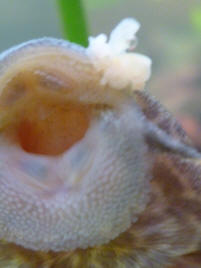
|
|
Sucker 12/26/16
Dear find
I have a sucker fish from 2 year I have brought 2 sucker but one died with
in 6months and other one is energetic and eating much but he/she is not
growing in size
My question is if sucker is 2year old what will be its size?
Thank you
Enil
<This is a juvenile Pterygoplichthys multiradiatus or some very similar
species. It should get to 45 cm/18 inches in length. Certainly 20 cm/8
inches within 1 year, 30 cm/12 inches by the end of the second year. If this
catfish is not growing, despite being well fed, it may have intestinal
worms. Treat with something like Praziquantel or Levamisole. Hope this
helps, Neale.>
<Oh! Enil, this is a friend of Neale Monk's; another WWM volunteer. I'd like
to add that the albino Pangasius catfish in your photo will get VERY big...
and could cause trouble in terms of waste production, possibly ingest some
of your other livestock. Please read here re:
http://www.wetwebmedia.com/fwsubwebindex/PangCatCompF.htm
and the linked files at top. Bob Fenner>
|
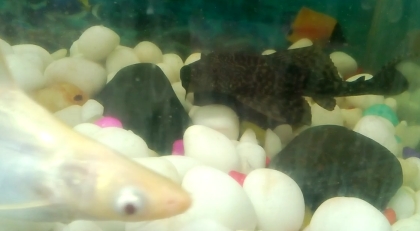 |
|
Odd growth on my pleco's mouth
10/25/10
Hi there, I'm hoping you can help me.
Roughly a week ago I noticed this fluffy looking growth on the
edge of one of my pleco's mouths. I'm not sure how long
it's been there but it doesn't appear to have grown any
over the last 7 days. My other Pleco is unaffected and the one
with the growth is still eating and behaving normally. The rest
of the tankmates detailed below are also fine. Any help or advice
would be much appreciated.
Tank 200 litres
Temp 25 C
pH 7.2
Ammonia 0
Nitrites 0
Nitrates <5mg/l
2 Plecos, 2 small angels, 5 red wag platys, 6 scissortails, 5
zebra/pearl Danios, 2 African dwarf frogs, 4 japonica shrimp
Many thanks in advance
Claire
<Hello Claire. First things first, your aquarium will soon be
much too small for your Plec, which is a Common Suckermouth,
Pterygoplichthys multiradiatus. While I doubt that's the
reason why this chap is sick, in the long term water quality
problems are going to stress your other livestock. Plus, two
Common Suckermouths will rarely cohabit in a tank this small, and
often they fight, in some cases causing such damage the weaker
fish dies. As for what precisely is going on here, well, your
Plec has some sort of growth, but whether it's viral or
bacterial is hard to say. Either way, it's likely to be
"benign" in the sense of not causing any immediate
health problems, but on the other hand there's no particular
cure for these
sorts of things outside of a trip to the vet for surgery and
suitable wound cleaning and antibiotics. It may heal in time,
given optimal environmental conditions and a balanced diet. One
last thing Claire, please do note that we ask for images to be
resized down to 500 KB each, rather than the 3 MB images you
sent, presumably fresh from the camera. Big files clog up our
e-mail allowance and cause other people's messages to be
bounced back.
Cheers, Neale.>
|
|

|
|
Re: Odd growth on my pleco's mouth
10/25/10
Dear Neale, Many thanks for the very quick reply and the helpful
info. I plan on getting another, larger tank and will now do that
sooner rather than later. I'm obviously pleased that the
growth is likely benign as I'd hoped that would be the case.
With regards to the file size of the photos I must apologise. I
had put them from camera into the computer and had a set with
reduced size as well as the originals. I sent you the wrong ones.
I will be more careful should I need to send pics again. Many
thanks again for your help. Claire
<Glad to help, Claire, and no harm done. Good luck,
Neale.>
|
Advice on transporting my Pleco
8/21/10
Hello wet web media crew,
<Hello Hannah,>
I hope my email finds whoever answers it in good spirits.
<Does indeed.>
I've got a rather difficult task on my hands that I wish to consult
about.
I have a 55 gallon tank with a 14 inch, 11 year old Pleco. I dearly
love this fish, but after much thinking I thought it would be best to
get him a new, larger home. My mom has a co-worker with an
appropriately large, well maintained pond of Koi (I've been assured
this is a safe place for a Pleco to live. True?),
<Assuming it's warm enough, sure, Plecs can be kept outdoors.
Minimum water temperature for a Common Pleco (such as Pterygoplichthys
pardalis) is about 22 C/72 C. Short term temperature drops to 18 C/64 F
will be tolerated during the winter, but anything colder than that is
lethal. A few pond keepers have been lucky and seen their catfish
survive cooler conditions, but on the whole these are tropical fish,
and there's ample evidence from Florida that established
populations of Plecs die off during cold winters. Now, as for mixing
them with Koi, it has been done. However, there have been many
instances of Plecs "sucking" at the mucous of both Goldfish
and Koi. These mostly occur in small ponds where the victims can't
swim away easily, but even in a big pond there's an element of
risk.
Sucking damage is obvious and severe, and obviously allows secondary
infections to set in. Once the catfish is in the pond, it's
extremely difficult to remove because it lives at the bottom, is well
camouflaged,
and basically nocturnal. Taking a "wait and see" approach may
therefore be impractical. So on balance, I wouldn't do this, but
it's up to you to make your own opinion. I've asked Bob to
chime in here, and perhaps he can say something more concrete.>
<<I do agree w/ what Neale has mentioned. RMF>>
and we're stuck on how to transfer him. My question is about how do
safely transfer him and acclimate him to his new home. I've heard
suggests of getting a 5 gallon bucket and trying to get him out of the
tank via a large container. Is this a good method? Or is there a better
method? Forgive me if this has been asked and answered before, I did a
search and couldn't find what I was looking for, and as your site
is my trusted source of caring for my fish I thought is best to
ask.
Thank you very much,
Hannah.
<Hannah, really, moving a Pleco isn't going to be a big deal.
They're air-breathing fish and generally very hardy. I'd start
by using a large bucket, 5 gallons is good, or something like a large
cool-box. Use enough
water to cover the fish, but there's no need to completely fill the
thing unless the trip is going to take more than a couple of hours.
Don't use an air-tight lid; instead, simply cover the top with a
towel so that the
catfish is in the dark and can't jump out. Some lids can be clipped
on loosely, and if you can do that, that's fine too. Either way,
get the catfish to its new home. Once there, acclimate as you would
when
introducing a new fish to your aquarium, using some variation of the
"drip method" across an hour or so. Obviously, the pond's
conditions have to be within the tolerances of the Pleco, in particular
with regard to water temperature and pH. Cheers, Neale.
|
Pleco belly turning white? 2/8/10
Hello,
<... 16 Megs in pix?>
I am concerned about my Pleco , who I have had for 10 years.
Recently his belly has turned a grayish white color.
<I see this>
It doesn't seem to bother" Mr. Bigfish", as he is
still eating , sucking, swimming, and pooping away....
Always swims to the top of the tank on the side to say hello when
I talk to him...He has always been a happy healthy fish.
The only thing I have read as this is normal with older age but I
really want to make sure as we love our Mr. Bigfish.
He is very well fed, clean home, vacuumed regularly and great
temp and PH...all checked daily , as he is a big pooper...
His belly used to have a very black and white contrast of a maze
like the color on his sides...I started using Melafix today just
in case...
<I would not use this product period. See WWM re>
I have included some pictures..Please tell me if this is normal
or of there is something I must do for him.
*Pictures can be enlarged for you.....Thank-you very much for any
help!
<This fish is likely fine. Some such changes in colour are due
to variable water quality... in turn accounted for in being in
too-small volumes, inadequate filtration, maintenance. Please
read here:
http://wetwebmedia.com/FWSubWebIndex/loricariids.htm
and the linked files above. Bob Fenner>
|
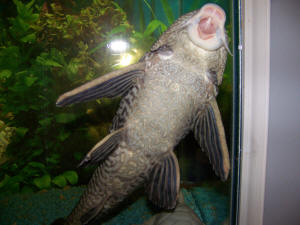 |
|
Re: Pleco belly turning white? 02/08/10
Hello Bob,
<Hello again>
Thank-you for answering so fast.
First, I must say I am very sorry for the size of my pictures I
thought I had made them smaller and included a link for the
larger size....
<Ahh! I understand>
I fear with what you have told me that Mr. Bigfish needs a larger
home.
<Some Loricariid species get REALLY big indeed... I got to be
in a "mud wrangling contest" at a Tampa fish farm once
with Pterygoplichthys that were well over two foot in
length!>
He lives in a 30 gallon tank all to himself as he doesn't
play well with others...He is 17".
<Yikes!>
How big of an aquarium should he have to be happy?
<Really? About six plus foot in length>
I change 50% water weekly and vacuum , I use a AquaClear
powerhead undergravel filter that pumps 175 gph, I keep his PH
7.0 and temp 75.
I also add PH up to keep up with the PH between water changes, as
well as using a net to scoop the poop daily.
I read the link you sent...Thank-you. I couldn't find
anything regarding not using Melafix on WWM...
<Please read here:
http://wetwebmedia.com/FWSubWebIndex/phonyfwmeds.htm
or just use the search tool... on every page>
Although I did stop using and did a 50% water change this morning
...could you please send me a link?
<Done>
Love this site as your articles have helped me in the past to
establish this clean home.
<Am very glad that we have aided your efforts>
I never expected to have such a big fish but he is my beloved pet
and I want to spoil him as best I can.
Thank-you again for your time in helping me...
<Certainly welcome. BobF>
|
|
Sick Pleco, Really Need Help 1/29/10
Hi. I've been researching online and reading posts on your
site, which is really excellent.
<Thank you.>
After what I think has been a pretty good search, I'm still
not sure about how to help my sick Pleco and am in desperate need
of expert advice. I don't know the gender, age, or type of
Pleco, but "he" is about 6" long and I've
attached some photos in case that helps.
<Pterygoplichthys pardalis, likely a male given the size of
the genital papilla.>
I apologize in advance for the long history that follows. It may
not be relevant but so much has happened in my fish tank that I
am including it in case it provides some clue to the best
treatment plan.
<OK.>
I am a relatively new aquarist but have had more than my share of
problems with this tank.
<Problems of your own making, I'm afraid. Looking over the
selection of fish for example, you've made bad choices, and
then misdiagnosed problems and probably caused them through poor
water quality. While I'll do my best to explain where you
went wrong, I fear you're going to get a bit annoyed with
me.>
It is a 25 gallon tall tank with an undergravel filter and a
Marineland Magnum Pro filter/bio wheel.
<This aquarium is less than half the size needed for your
Plec.
Pterygoplichthys pardalis is barely viable in a 55 gallon tank,
and realistically needs something 75 gallons upwards. Be under no
illusions here: healthy fish reach a length of 45 cm (about 18
inches) within two years. They are incredibly messy herbivores,
and will completely overwhelm your filtration system.>
It was given to me by a friend 5 months ago, along with the
Pleco, 2 lemon tetras, 1 angelfish, 1 cardinal tetra, 1 phantom
tetra and a Cory cat.
<Some friend...>
The tank and fish were not very healthy (pH was lower than 6.0
and the angelfish had lip fibroma, big white granules that were
not Ick, scales falling off, problems with slime coat, etc.).
<Not a "Fibroma" but either Columnaris or Finrot,
two very common bacterial infections that set in when fish are
exposed to chronically poor conditions.>
The cardinal did not survive the move. I did a lot of research to
try and prevent any more casualties and kept a close eye on water
quality (tank cycled quickly because biofilter was already
established) but despite heroic measures, the angel died about
three weeks later, and the phantom tetra about a month after
that. He had no visible problems but just stopped eating and did
not respond to any treatment.
<Again, I suspect you misjudged water quality and water
chemistry. For a tank like this, you're aiming for slightly
soft to moderately hard water, with a neutral to slightly basic
pH; in other words around 10 degrees dH and a pH around 7 to 7.5.
Do read:
http://www.wetwebmedia.com/FWsubwebindex/fwh2oquality.htm
>
All seemed stable for about a month so I started adding more fish
in two week intervals. I was aiming for two schools of 7 tetras
plus the Cory and the Pleco, which based on my reading seemed OK
but the more I learn about Plecos still may be too many for this
tank (?).
<Indeed.>
First I added 3 phantom tetras, then 2 lemon tetras, and finally
3 more lemon tetras. Unfortunately, I did not quarantine these
fish. One of the last three I added died within 48 hours and
another stopped eating and then started swimming sideways so I
moved her to an already established hospital tank. This happened
late last November. On advice (always) from a local fish store I
treated her with Maracyn Two. She stopped swimming sideways
within a day but still was not eating after full treatment. Then
I tried General Cure and something called "Lifeguard",
which killed the biofilter in the hospital tank but she finally
started eating again. Joy!
<Adding random medications without diagnosing the problem will
merely kill your fish. Imagine if your doctor just gave you the
first packet of pills he laid is hands on! You might get aspirin,
or you might get warfarin! So you have to be sensible here.
Relying on your pet store is, frankly, foolish. Grab an aquarium
health book -- I assume you have at least one aquarium fish for
beginners book -- and read through the diseases. There really
aren't that many diseases to worry about, and in almost all
cases they're caused by bad fishkeeping.
http://www.wetwebmedia.com/FWsubwebindex/fwdistrbshtart.htm
http://www.wetwebmedia.com/FWsubwebindex/fwfishmeds.htm
Do remember that some medications (e.g., ones with copper in) are
toxic to catfish, loaches and certain other fish. Do also
remember that carbon -- if used in your filter -- will remove
medications before they have a chance to cure your fish.>
In the mean time, however, one of the original (male) lemon
tetras in the main tank was becoming increasingly aggressive,
chasing the others around until they hid behind filter
inlets.
<Schooling rarely behave properly when kept in less than six
specimens.>
He was especially mean to the other original (male) tetra, who
along with several others was starting to look like he had fin
rot. FYI, the lemon tetras also have a white tip on their nose,
which gets worse when they are stressed but is not furry. I
showed this to someone at a fish store told me they thought it
was some kind of color variation but that doesn't seem right
to me. He suggested that I remove the aggressive fish, and put
the previously sick (but now eating) fish back in the main tank.
BAD IDEA.
Within 24 hours she was swimming sideways again. So once again, I
cleaned and changed water in the quarantine tank and put the
aggressive one back in the main tank. I tried two more rounds of
antibiotics in the hospital tank but she never swam upright
again. After much soul searching I euthanized her. This was a
week ago but it still feels awful.
<OK.>
Back in the main tank, the one that had been getting picked on
originally has now become the new bully and the formerly
aggressive one who left and has now come back to the tank is
hiding and not eating, though he still chases the females around.
There seems to be lots of spawning going on in this tank, which
makes me think the water quality is OK. Right now ammonia is 0,
nitrite 0, nitrate 20, and pH 7.6. It is a planted tank and I use
RO water with equilibrium, alkaline/acid buffer, Flourish, and
Flourish excel added. I haven't been able to get the pH
lower, it always climbs back up and sticks around 7.6. GH is 4,
KH is 4.
<This water chemistry is fine, provided it is stable.>
Finally, back to Mr. Pleco. He seemed absolutely fine through all
of this except that about a month ago I noticed that he was
coming up to the top of the tank when I fed the other fish and
eating on the surface, which seemed like very odd behavior for a
Plecostomus.
<They will gulp air when kept in poor water quality. Indeed, a
tank this size with so many fish may not even have enough oxygen.
This is especially problematic for catfish because they are at
the bottom of the tank where there's least oxygen
anyway.>
I had been feeding him a slice of zucchini or broccoli about once
a week and the fish store salesperson said he was probably
starving. He sold me some wafers about the size of a nickel and I
started feeding him one each night. Then I noticed that his belly
was kind of bloated so I thought it might be too much and started
alternating days.
<That's fine.>
About a week ago I noticed him belly up and breathing heavily for
a short time and the last few days he seems to be struggling with
his buoyancy, not sucking on the side of the tank as much or
slowly floating upwards when he does. He hides under plants, as
if he needs them to hold him down, and he seems to be active a
lot during the day whereas he used to hang out under the rock.
From the posts, I thought he might be constipated, but he has
actually been making huge amounts of poop - long strings about
4" - 6" long or more. It is all over the tank. They are
dark greenish color, a bit like the color of the wafers. It also
sounds from the posts that a problem like this could be an
internal bacterial infection, eggs, or tapeworms. I can see from
one of these photos, though I had not noticed it earlier that his
gills are very red inside. He is clearly not a happy guy (or
girl), but I just don't know what to do to help him. Should I
stop feeding him the wafers?
<These are fine, but wouldn't use them every night; 3-4
nights per week is fine.>
Move him to a hospital tank or maybe treat the whole tank? If so,
with what? I'm not really trusting the fish stores for advice
any more.
<Indeed.>
I love my fish tank, it gives me so much pleasure to watch them
and care for them but I'm not sure how much more suffering
and death I can handle.
<Do start by reviewing stocking density, and then thinking
about what types of fish to keep. Not all fish work in all tanks,
and not all the fish commonly sold either get along or are easy
to keep.
http://www.wetwebmedia.com/ca/volume_5/volume_5_3/stocking.htm
http://www.wetwebmedia.com/FWSubWebIndex/fwlivestk.htm
http://www.wetwebmedia.com/FWSubWebIndex/fwlvstksel.htm
>
I feel so responsible for these little lives and my small garden
is running out of burial space. I've thought about tearing
down and sterilizing everything but the idea of cycling a
"new" tank with all these fish,
<No, this wouldn't fix anything. Once an aquarium is
cycled, treat the live filter bacteria like gold dust!>
especially when they are not healthy doesn't seem like the
best idea either.
<Much fish health is opportunistic. When fish are provided the
right conditions, their immune systems fight off the bacteria;
when fish are weak, the normally harmless bacteria cause
problems.>
I can understand why so many people give up on this hobby.
<Usually the ones who fail created their own problems. If you
read and plan ahead, and do things precisely "by the
numbers", it's actually a very easy hobby.>
Thank you so much, I am grateful for any advice you can
offer.
<Suspect nothing actually wrong with the Plec beyond poisoning
by overuse of medications and/or poor environmental conditions.
Do a series of water changes to flush out the tank. Optimise
water quality. Stabilise water chemistry. Stock the tank
sensibly. Return the Plec or move it to a much larger aquarium.
Buy a book.
http://www.wetwebmedia.com/FWSubWebIndex/bksfwbrneale.htm
"A Practical Guide to Setting Up Your Tropical Freshwater
Aquarium" is cheap and covers all the key aspects nicely.
"Manual of Fish Health" is heavier reading, but a good
book on fish health, water chemistry, and other practical
aspects.>
Lauri
<Cheers, Neale.>
|
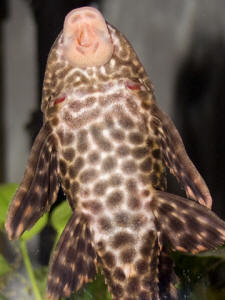 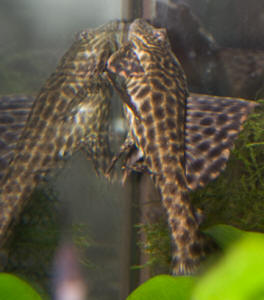 |
|
Re: Sick Pleco, Really Need Help 01/29/10
Hi Neale and thank you so much for your quick and very thorough
response.
<Always happy to help.>
It sounds like despite good intentions I have been my fish
tank's worst enemy.
<You are not alone in this, so don't feel too bad. We
aquarists create most of the problems we have to deal with. On
the up side, most problems are easy to avoid, and fixing them
once they've occurred isn't necessarily difficult. But,
as is often the case in life, forethought is the key.>
Specific to the Pleco, I want to clarify that I have never put
any type of medication in his tank, the main tank, so that leaves
environment/water quality as the most likely cause of his
problems.
<Does sound probable.>
From what you are saying, even though the chemistry is fine
(those numbers have not changed very much for months), the water
quality is likely bad because the current population mix is
causing too much waste for the system to handle.
<Again, sounds a logical deduction.>
Since a larger tank is not an option right now I will focus on 1)
getting the water in pristine condition and 2) finding the Pleco
a better, larger home.
<I suspect that (2) will largely make (1) happen all by
itself. A 25-gallon tank is actually a pretty good size for, say,
15-20 small, Guppy-sized fish. Throwing in a Plec is where the
problems begin...>
I did a 40% water change last weekend but will do another right
away with a very thorough gravel cleaning and continue to do so
weekly (? I had previously been doing 5 gallons every 2-3 weeks)
until he is feeling better
and can be adopted.
<Yes, water changes will help. Cleaning the gravel tends to be
neither here nor there, though a good stir before you siphon out
the dirty water is very beneficial.>
I do own and have read cover-to-cover a guide to freshwater
aquariums.
<Cool. But you'd be surprised how many people haven't
read a book since they left school.>
I have scoured the Web for info, and consulted with
"experts" (fish stores, fish forums). There is so much
info out there, often conflicting, that it can be confusing and
difficult to know who or what is right.
<Yes, I appreciate this. It's difficult to know who to
trust. One advantage of having a book is that you can compare
what the book says with what your advisor says. Books are edited,
and the people who write them are normally experts. So book
content is generally good. Yes, some books contain errors or old
fashioned ideas, but mostly what books say about the basics is
very reliable. To our credit, at least some of the crew here at
WWM are book and magazine writers, and all the crew will have
been "screened" by the older crew members before being
set loose on the Daily FAQs. So while we may sometimes be a bit
harsh, you can at least be sure what we're saying is based on
real expertise rather than bluff.>
One place swears by salt, another says salt is really bad,
etc.
<Often times, it's the shades of grey that cause problems.
Catfish aren't "allergic" to salt as some suggest.
Indeed, some catfish live in brackish water, and some even live
in the sea. But not all catfish are equally tolerant of salt, and
the amount of salt matters. Your Plec for example will tolerate a
little salt rather well, and compared to copper-based Ick
medication, adding a little salt to treat Ick would actually be
kinder and safer. On the other hand, adding salt on a constant
basis doesn't provide any benefit, and those catfish that
need soft water, like Corydoras, may be stressed by it over time.
So the problem is when people make sweeping generalisations
without considering the outlying data points.>
I guess the best thing is to pick a source I feel I can trust
(your site and one of the books you recommend) and then do it, as
you say, "by the numbers".
<Quite so. Your tank is probably more or less stable in terms
of filtration. Remove the surplus fish, and the filter should
settle down nicely, and a couple of schools of midwater fish, and
maybe five Corydoras, could happily be maintained with few if any
problems.>
Thanks again for your feedback, it stung a little but I very much
appreciate the help.
<Then my work here is done.>
Lauri
<Cheers, Neale.>
|
|
|

